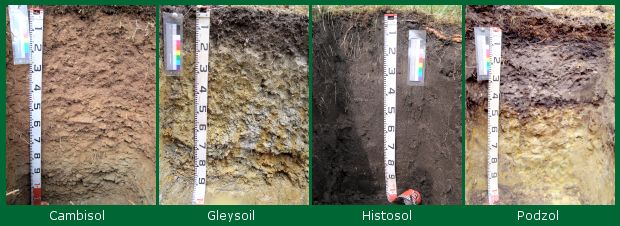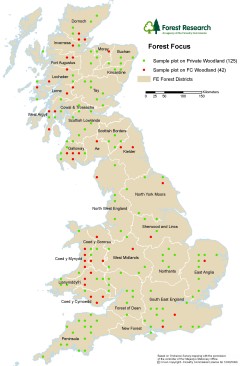Summary
Background
Forest Focus Regulation (EC) N 2152/2003 was adopted by the European Commission to broaden the scope of the monitoring scheme from the protection of forests against atmospheric pollution and forest fires toward other environmental issues such as soils and forest biodiversity.
BioSoil is a demonstration project, part of the programme of the International Cooperative Programme on the Assessment and Monitoring of Air Pollution Effects on Forests (ICP Forests). This project was a test for the development of operational soil monitoring at a large scale.
- ICP manual on methods and criteria for harmonised sampling, assessment, monitoring and analysis of the effects of air pollution on forests soils (link to external webpage)

Biosoil plots

Plot locations for the BioSoil survey in the UK.
There are 167 BioSoil plots on 16 x 16 km grid in the UK, of which 125 on private woodland and 42 on Forestry Commission Woodland.
Plots were installed in 2006 by Forest Research Technical Services Unit.
The soil survey was carried out by two groups of professional soil surveyors, one based in England (Land Research Associates) and one in Scotland (Andrew Hipkin and Gordon Hudson).
All 167 plots have been surveyed and the field information and soil description are under processing. Soil samples are processed and are being analysed by our chemical analysis laboratory.
BioSoil project – soil component set-up
BioSoil was a demonstration project, part of the programme of the International Cooperative Programme on the Assessment and Monitoring of Air Pollution Effects on Forests (ICP Forests). The project was a test for the development of operational soil monitoring at a large scale.
In order to achieve the required objectives of the soil component of this project, the following main requirements have been implemented.
Soil sampling
The basis for the BioSoil implementation was in principle the current version (updated 6/2003) of the ICP Forests manual: ICP manual on methods and criteria for harmonised sampling, assessment, monitoring and analysis of the effects of air pollution on forests soils (link to external webpage)
The sampling strategy adopted for this project included all sites of the 16 km by 16 km Level I network of the EU Member States which participate in the project.
Measurements and analyses
Measurements and analyses performed on BioSoil plots included all parameters (mandatory and optional parameters according to the ICP Forests soil manual) for organic soil horizons and the mineral soil layers 0 to 10 cm, 10 to 20 cm, 20 to 40 cm and 40 to 80 cm according to the revised manual of procedures.
Analyses were performed at National level by laboratories that performed well in interlaboratory comparison exercises following the analytical procedures described in the manual.
A subset of the samples from benchmark BioSoil plots (corresponding to ca. 10% to 15% of the total sites) were analysed in parallel by a central laboratory. The central and the national laboratories participated in future interlaboratory comparison exercises organised within the framework of this project.
Soil profile
Following the ICP Forests soil manual, a full soil profile description according to the FAO guidelines (1990) and classified according to the World Reference Base WRB (1998) was provided.
This pedological information was centrally stored in a newly developed soil profile database.
BioSoil project – biodiversity component
The BioSoil project was a pan-European demonstration project, part of the programme of the International Co-operative Programme on Assessment and Monitoring of Air Pollution Effects on Forests (ICP Forests).
Forest biodiversity
Within the effort to develop guidelines for assessing and estimating the loss of forest biodiversity in Europe the BioSoil project aimed to select and test simple and suitable indicators of forest biodiversity at stand as well as European level with the scope for a large scale monitoring system for Europe.
Following a meeting of biodiversity experts from the Member States in co-operation with the Joint Research Centre of the European Commission, the biodiversity survey was based on a stand structure approach which assumes an increased potential for biological diversity with increasing complexity of the forest stand.
Assessment details
The forest type for each plot was classified according to the age, origin and composition of the stand and any known previous land-use and stand management information.
The main focus of the stand structure approach was on structural forest diversity measured as:
- Diameter at breast height (dbh) and species composition of all woody plants, including living trees, standing dead or lying dead
- Deadwood, snags, stumps and coarse woody debris and their decay state
- Canopy characteristics such as canopy closure and number of tree layers.
To complement the structural parameters, the vascular plant communities of the ground vegetation were also assessed according to the Flora Europaea, bryophytes or lichens were not considered on this occasion.
More details on objectives and methodology can be found in:
BioSoil Forest Biodiversity Field Manual (PDF-294K)
The biodiversity survey was carried out by surveyors from the extensive network of field stations of Forest Research’s Technical Services Unit in 2006 and 2007.
The biodiversity survey data was submitted to the European Commission’s Institute for Environment and Sustainability (IES) in Ispra, Italy, for a joint analysis for all Member States.
BioSoil project – soil component objectives
BioSoil was a demonstration project, part of the programme of the International Cooperative Programme on the Assessment and Monitoring of Air Pollution Effects on Forests (ICP Forests). The project was a test for the development of operational soil monitoring at a large scale.
The following specific objectives were defined for the soil module of this project:
- To establish an improved common European baseline of forest soils for environmental applications (e.g. acidification and/or eutrophication; C stock (because sink/source will be difficult to quantify with the monitoring data) assessment, impacts of climatic changes.
- To finalise the common European methodology for forest soil monitoring on the basis of the ICP Forests and other relevant guidelines:ICP manual on methods and criteria for harmonised sampling, assessment, monitoring and analysis of the effects of air pollution on forests soils (link to external webpage)
- To upgrade the quality of the existing forest soil database (e.g. according to recent manual, complete the database for available information, including soil profile descriptions, chemistry of deeper soil layers, method codes, data base structure).
- To quantify spatial variability on the basis of information available and supplementary field experiments.
- To detect and explain temporal changes in forest soils.
- To improve the actual evaluation concepts, in specific by more advanced statistical analysis procedures including estimation of uncertainties
- To evaluate the applicability of the methodology adopted by the European forest soil monitoring programme before setting up the monitoring for other land use types
- To improve the existing quality assurance/quality control strategy for European forest soil condition survey.
Research Objectives
The project was based on a strategy of describing and sampling soils on a 16×16 km grid network that fall onto forested land, and was the single largest soil monitoring exercise implemented so far at the EU scale.
Its primary aim was to establish an improved common European baseline of forest soils for environmental applications (e.g. acidification and/or eutrophication; carbon stock assessment, impacts of climatic changes, etc.) but also evaluate methodology before EU-wide monitoring programmes for other land use types are set up.
It included a soil component and a biodiversity component.
Latest Update
The BioSoil project in the UK was led by Forest Research. Timing of the various actions were:
- Preparation: July to December 2005
- Establishing the 16 by 16 km network in the UK: January to April 2006
- Soil survey: April to December 2006
- Soil analysis: October 2006 to December 2007
- Soil data management and report writing: December 2007 to December 2008.
BioSoil information and data has been compiled and submitted into EU database. Soil resampling of a number of the Level II sites has been carried out during 2016-2017.
